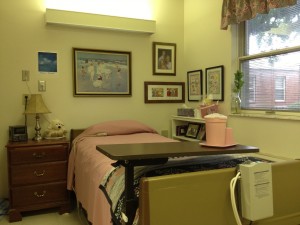Life in Skilled Care – We made it through the transition.
Now that two months have passed since we moved momma into a nursing home, I can step back and see how we have progressed. Our goal to get as close to my aunt’s room as possible is why we moved next door to her in a semiprivate room that offered a very small area. It didn’t help that the roommate sported an electric scooter that took all space and more to maneuver in and out. Coupled with a bad design of the door to the hall and the door to the bathroom being back to back required adjustments to accommodate any movement. Fiercely independent, we would often watch as the roommate moved back and forth in slight increments to weave between the dresser and foot of the bed to go through either door. Often the furniture was knocked cockeyed from the attempts to get through, leaving the room in a state of dishevelment.
The tight living space inconvenience was overshadowed by our next challenge – getting to know the staff and they us. We got off to a rough start as I was expecting Momma to maintain the routines she had before we moved her here. Although Momma can’t express her position with words, she shut down her remaining communication skills other than the expression of fear. Seeing her react to her new “handlers” that way was distressing to us both. I responded by taking her off the unit to explore the building while I was there to distract us both from what we had signed up for. We spent time meeting other residents from other parts of the building and even explored possible new rooms to transfer to. A private room became available which was offered to us as I had made known that we hoped for a bigger space. Since this opportunity resided in a different unit at the far end of a hall away from most activity, we chose to hold out for an opening in the current wing where we had begun to get acquainted with residents and staff and still be close to my aunt.
I am happy to report that my concerns did not go unnoticed by most staff involved. The day a larger semiprivate space came available across the hall from my aunt, I felt sure we would be moving soon. I even arrived the next day with my hammer and tape measure for hanging pictures just in case we were given the go ahead. Sure enough, upon my morning arrival I was greeted with smiles and an offer of moving. I said yes and immediately we began the quick task of moving from one room to the next. The hammer came in handy so by lunchtime, the space was as cozy and familiar as possible. Momma did not seem unsettled by the change and accepted the bigger accommodations without complaint. The window view and better tv reception brighten the room and our new roommate and family visitors are congenial.
Meanwhile, we have become more relaxed with the staff on all levels and many times prefer to join the other residents in the day room over going to activities in the larger activity room away from the unit. The residents have become endeared to me and I enjoy interacting with them as a group or one on one. Momma does enjoy my undivided attention, however, and I am sensitive to her needs first.
All in all, I can look out our open door into my beloved aunt’s room across the hall when we are in the room, enjoy the day room down the hall, get ice cream out of the freezer or ice and water at will, or check at the nurses station of any recent information concerning my mother’s daily habits. We’ve learned to stick around until momma is cared for before wandering off somewhere else in the building and make an effort to be back in time for the afternoon snack. We learned we can use our earned funny money from the activity department to buy a box of Kleenex from them when needed and purchase other items from their monthly store.
This journey we’ve been on began in late 2008 with the first move to assisted living. After three and a half years, we moved to memory care. Less than a year later, we moved to skilled care. Enduring the transition each time was difficult but necessary to keep moving forward. As expected, it wasn’t an easy two months this time but worth getting through. I am free to come and go, Momma and my aunt are settled in and are both under the care of hospice and the facility. Their affairs are manageable now as long as I keep things going on a regular basis, paying bills and balancing checkbooks frequently.
I am thankful for where we’ve been, who we’ve met along the way and where we are. My main emphasis now is to enjoy the relationship I have with these precious treasures who have my undying love.




Recent Comments